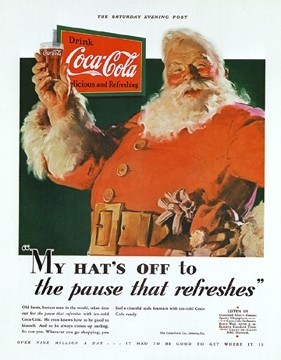

Photo: Coca-Cola
History has offered many representations of Father Christmas, who has appeared in a range of clothing and colors over time. Perhaps the most famous portrayal, however, is that of Saint Nicholas of Myra, a 4th Century bishop depicted in familiar red robes.
The popular myth that Father Christmas owes his appearance to Coca-Cola –– the portly stature, bushy beard and red outfit –– is not entirely accurate. Rather, the Santa Claus image you recognize today was the image portrayed by Haddon Sundblom for Santa’s first appearance in Cola advertising in 1931, drawing inspiration from Saint Nicholas’ image.
Indeed, of the many contemporary portrayals of Father Christmas, Coca-Cola conveniently selected — as opposed to invented — the image we know today.
Of course, this imagery conveniently matched their own famously colored branding.
Cola’s campaign has evolved over time, showing Santa in a range of scenarios which any customer might find familiar:
- ‘Me too’ in 1936 was Santa in the Great Depression
- ‘Give and take, say I’ showed children leaving out Cokes for him at night in 1937
- In 1961, Santa attempts to hush the family dog ‘When friends drop in.’
Part of the campaign’s success is in engaging Santa in recognizable scenes. Customers reactions and traditions have followed. After 1937, children started leaving out Coke at night, while after another campaign showed Santa without a wedding ring, concerned fans wrote to Coca-Cola asking where Mrs. Claus had gone.
In adopting such a quintessential seasonal character, Coca-Cola can safely repeat their campaign each year. People expect to see Santa and, much like his wedding ring, would likely now question if he failed to make an appearance on Cola’s behalf.
While the red and white branding similarities are largely fortuitous for Coke, there can be little doubt that this has helped seal the association between the brand and Santa in people’s minds.
Holiday Marketing Takeaway
Is there is a well-known seasonal character whose features already match some of your branding? If “yes”, capitalize on this to build long-lasting associations in consumers’ minds.

